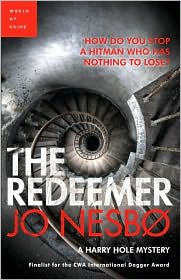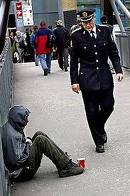“[Being a Redeemer] is God’s job…If God doesn’t do His job, though, someone else has to do it.”
A man’s  compulsion to do what he considers good and right, even though it requires him to act in ways that society and the law consider morally and legally wrong, permeates this book on all levels, with several characters assuming this role of “Redeemer” in their actions throughout the novel. Often these characters justify their actions to themselves by believing that these actions are less wrong than the actions of their victims—that society, they themselves, and sometimes even their victims are better off as a result of their actions as “redeemers,” which most often result in deaths.
compulsion to do what he considers good and right, even though it requires him to act in ways that society and the law consider morally and legally wrong, permeates this book on all levels, with several characters assuming this role of “Redeemer” in their actions throughout the novel. Often these characters justify their actions to themselves by believing that these actions are less wrong than the actions of their victims—that society, they themselves, and sometimes even their victims are better off as a result of their actions as “redeemers,” which most often result in deaths.
Norwegian author Jo Nesbo, in this fourth novel of the Harry Hole series to be published in English, introduces three seemingly disparate plot lines in this thriller set in Oslo—a hired assassin from Croatia is fulfilling contract killings in Europe and has just arrived in Oslo for his last job; the Salvation Army, its officers and soldiers, are trying to fulfill their mission by providing food, clothing, and shelter to those most in need of their help, no questions asked; and Harry Hole, an alcoholic police inspector, who is sometimes off-the-wagon, is still trying to find the Big Boss behind the gun-running and related crimes which brought down one of his fellow police inspectors in The Devil’s Star, the previous novel in this series. Despite his unwillingness (and sometimes inability) to follow the rules, Harry believes in justice, no matter how it is brought about. He, too, can be a Redeemer.

To add to the complexity (and occasional confusion) of this very complex mystery, there are a number of characters who are similar. In the Salvation Army subplot, two brothers look almost identical, though Jon is more likely to become the new head administrator for the Salvation Army in Oslo than Robert. Both are in love with the same woman, though one of them may be a sadist with a long history. The woman, Thea, is also a member of the Salvation Army, and her brother Rikard is a major player. Another attractive young woman, the daughter of the Salvation Army Commander, is also involved in the romantic angles, and it is easy to mix up these characters.
In the other plot lines, the assassin who has come to Oslo from Croatia has a characteristic called “hyperelasticity,” which enables him to mimic with his facial structure, a number of different facial types, so descriptions of this person vary significantly when he commits a murder. Harry himself is still not exactly stable. Though he seems to be reconciled with the fact that his long-time love, Rakel, has written him off as an unacceptable suitor, despite their apparent love, Rakel’s young son still clearly loves Harry, and Harry seems to be still pining for Rakel. Harry’s determination to find the man behind the arms-smuggling operation which was the focus of The Devil’s Star, raises questions about all the other representatives of the police department, and the reader realizes that s/he cannot take anything involving the police at face value.

Panhandling is not illegal in Norway.
Nesbo is a compelling writer, one who has completely mastered the art of creating suspense and propelling the action along. In this novel, however, he does something new, which forces the reader to apply the kind of thinking that Harry Hole is required to do: Nesbo creates short action scenes in which he does not always identify the main character, presenting information for the reader to process and hold in the back of his/her mind till another piece of the puzzle is revealed to connect with it. He might, for example, end a scene with a phone ringing. When the next scene begins, someone picks up the phone, but it is usually not the person from the previous scene, and we do not always know who it is right away. Or Harry Hole may ring a doorbell, and in the next scene another person entirely will answer the door in a new scene in a new place. This is a clever technique for involving the reader, but it does sometimes create confusion by forcing the reader to backtrack to keep all the characters and their immediate stories straight.

Fretex Unika store in Oslo, the equivalent of a Salvation Army store
Eventually, the loose ends get tied up, but the extent to which the resolutions are realistic is an open question, and some readers may lose track of all the issues before the novel ends. Nesbo does reflect much of the atmosphere of Oslo and the attitudes of the police, but he has less of a sociological focus here than in the past. Here he seems to be more concerned with creating mysterious moods and complex plots which just happen to be located in Oslo. Harry has always been a loner, and he is a loner throughout this novel, but the reader feels, for much of the time, that s/he is getting to know him better. He, however, is still reluctant to reveal his true inner life. As he says, “I don’t believe in photo albums. They destroy the ability to forget.”
Note: The previous novels in this series are: (SEE WIKIPEDIA FOR ORDER OF RELEASE) THE REDBREAST, NEMESIS, THE DEVIL’S STAR, THE SNOWMAN, THE LEOPARD, PHANTOM, THE BAT, POLICE, COCKROACHES (1998), THE SON (2014), BLOOD ON SNOW (2015), MIDNIGHT SUN (2016), THE THIRST (2017), KNIFE (2019)
Photos, in order: The author’s photo is from http://bookblog.scandinavianbooks.com
Panhandling, which features in this novel, is not illegal in Sweden. Here a policeman passes a panhandler on the streets: http://coloradoright.wordpress.com
The Fretex shops (featured in this novel) are the Salvation Army shops which sell everything from clothing to furniture, china, artwork, and even dogs’ beds. Extremely popular, they are also famous for their attractive store windows, shown here (with reflections). See: http://www.spottedbylocals.com. Image by Kaja Marie Lereng Kvernbakken
For those like me who wonder about the novel’s vicious “black Metzner dog,” supposedly re lated to the speckled hyena, a new friend in Denmark did some googling and found an interview in Swedish with the author (http://www.dn.se ) in which Nesbo indicates that the dog is fictional. This information came from Dorte J, whose website is http://djskrimiblog.blogspot.com/ The hyena photo is from http://abubblingcauldron.blogspot.com
lated to the speckled hyena, a new friend in Denmark did some googling and found an interview in Swedish with the author (http://www.dn.se ) in which Nesbo indicates that the dog is fictional. This information came from Dorte J, whose website is http://djskrimiblog.blogspot.com/ The hyena photo is from http://abubblingcauldron.blogspot.com
